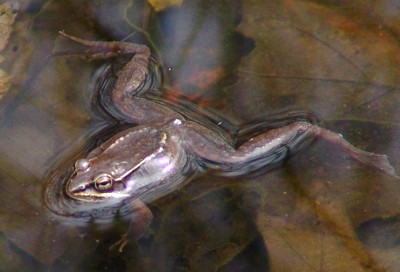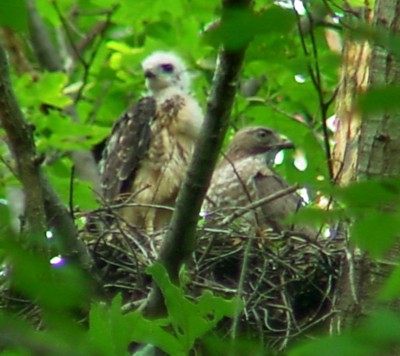| 2) Many
herps, such as frogs, salamanders and toads,
even though they are cold blooded, arrive at the ponds as soon the
ice has melted (and some times before) to breed and lay their eggs. |

Breeding Wood
Frog:
short video, longer video;
audio only |
Wood Frog Ecology:
1. Answer question
sheet for next class.
2. To find information:
|
|
|
|
3) Males
migrate earlier than the females on the northward migration in most
migrant birds. (But in the fall, males migrate later than the
females, and often do not move as far south.) |
|
|
Examples: Broad-winged Hawk, Northern Harrier,
Eastern Phoebe, American Robins, Red-winged Blackbirds, Cowbirds, and many
others. |
|
|
4) Why do birds migrate at all anyway?
Eastern Kingbirds eat flying insects almost exclusively in the spring in
our area. So I figured that they had to migrate to avoid the insect
shortage during our winters. Sound good? Then I learned that on
migration and on their wintering grounds in South America they are
entirely fruit eaters! (Species such as Robins, Waxwings, Starlings,
Crows, and others overwinter in our area eating mostly fruits.) Why not
Kingbirds? It would save all that time energy and dangers involved in
migrating more than 2,000 miles.
|
|
|
5) The best time to observe some snakes
(cold blooded) is early spring (late March/early April) on cool, sunny
mornings. Examples: Northern Watersnake, Garter Snake, Ribbon
Snake.

Water Snake ^
Ribbon Snake > |
 |
|

Spotted Turtle^
Painted Turtles > |
 |
|
|
6) The larger raptors are the earliest nesters. The
females are on the nest, in cold weather. Under these conditions they
cannot stop brooding their eggs, which would die in the cold, and they
must depend on the male to bring food. And after the eggs have hatched,
the young are even more sensitive to the cold. Some of these females are
stuck, on nests, brooding 24/7, for 2 months or more. Why not wait a
week, or a month, or more? (You think the females have it tough? The
males must catch enough prey, in the cold weather, rain or shine, to feed
himself, AND the female, AND the young after they hatch. That's pressure
on the provider!)

Broad-winged Hawk,
Adult and Young |
|
|
(Trying to make sense about nature - and all biology,
is really tough. A wide knowledge base is required (and a lot of it
hasn't been discovered yet), logic often fails, exceptions abound, and
there are way too many variables involved in most situations. Yet what
are we going to do, not try to understand what we observe??? So we try,
many times (most?) we are wrong, we get corrected and go on
it's
science.)
|
|
|
|
|
| |
|
| |
|
| |
|





